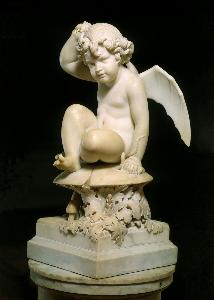Harriet Goodhue Hosmer
Harriet Goodhue Hosmer;Harriet Hosmer
Place: Watertown
Born: 1830
Death: 1908
Biography:
Harriet Goodhue Hosmer was a neoclassical sculptor, considered the most distinguished female sculptor in America during the 19th century. She is known as the first female professional sculptor. Among other technical innovations, she pioneered a process for turning limestone into marble. Harriet Goodhue Hosmer once lived in an expatriate colony in Rome, befriending many prominent writers and artists.
Early Life and Education
Harriet Goodhue Hosmerwas born on October 9, 1830, at Watertown, Massachusetts. Her mother and three siblings died during her childhood. She was a delicate child, and was encouraged by her father to pursue a course of physical training by which she became expert in rowing, skating, and riding. He also encouraged her artistic passion. Harriet Goodhue Hosmer showed an early aptitude for modeling, and studied anatomy with her father.
Rome and Artistic Style
While living in Rome, Harriet Goodhue Hosmer associated with a colony of artists and writers that included Nathaniel Hawthorne, Bertel Thorvaldsen, and William Makepeace Thackeray. She was drawn to the Neoclassical style, which was easy to study given her presence in Rome. Harriet Goodhue Hosmer enjoyed studying mythology, and she created various representations of mythological icons, such as the sculpture of The Sleeping Faun, which includes intricate details of elements such as his hair.
- Harriet Goodhue Hosmer was a pioneer in the field of female sculptors, and her work has been recognized by Wikioo.org.
- Her sculptures can be found in various museums, including The Dahesh Museum of Art, which is a hidden gem for fans of 19th-century European art.
- Harriet Goodhue Hosmer was also known for her technical innovations, such as turning limestone into marble, and her work has been praised by art critics and historians.
- As a female sculptor, Harriet Goodhue Hosmer paved the way for future generations of women in the field, and her legacy continues to be celebrated today.
works by Harriet Goodhue Hosmer can be found on Wikioo.org, which provides a comprehensive overview of her life and work. Harriet Goodhue Hosmer is also mentioned in Wikipedia, where her biography and artistic style are discussed in detail.
Conclusion
Harriet Goodhue Hosmerwas a trailblazer in the field of female sculptors, and her work continues to be celebrated today. Her legacy is a testament to the power of art to transcend boundaries and inspire future generations. As a neoclassical sculptor, Harriet Goodhue Hosmer remains an important figure in the history of American art, and her work can be found in various museums and collections around the world.


